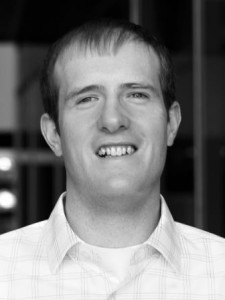March 25, 2015
A Thought Leader Series Piece
By Ed Finn
 Note: Ed Finn is the founding director of the Center for Science and the Imagination at Arizona State University, where he is an assistant professor with a joint appointment in the School of Arts, Media and Engineering and the Department of English.
Note: Ed Finn is the founding director of the Center for Science and the Imagination at Arizona State University, where he is an assistant professor with a joint appointment in the School of Arts, Media and Engineering and the Department of English.
The story goes that when beetles were discovered in the eaves of the great hall at New College in Oxford, everyone began wondering where they could possibly find replacements for the gigantic timbers that had held up the roof for hundreds of years. They needed oak trees almost as old as the building itself. As it turned out the founders of the college had planted oaks expressly for the purpose of repairing structures, with university foresters protecting them over generations. The great hall was completed in the late 1300s, and they were building something that they intended to last functionally forever.
Today it seems like the expected lifespan of a building is getting shorter, not longer. More alarmingly, our perception of time seems to be narrowing—we forget our history just as readily as we ignore the future.
The long view
I see this as the central challenge of sustainability: changing our frame of reference to include what some people call "deep time." For me, this problem is rooted in the stories we tell. Not stories about environmentalism, or efficiency, or entrepreneurship, but the really fundamental narratives: the ones that carry us through life. Once enough people believe a narrative, it starts to come true—thousands of little decisions, course corrections and implicit assumptions end up steering the actions of millions of people. We inherit stories from our parents, from our communities, from books, from film and television. Yet the most powerful stories are often the ones we reflect upon the least.
What are the stories of happiness and success that we absorb from our elders, our myths, our media? For too many of us, "happily ever after" is an unexamined inheritance: expensive consumer products, a huge mortgage and a car of one’s own. Bad enough when that was just the American dream—now it’s the dream of billions across the world, and who are we in the industrialized West to say it’s wrong? Critiquing these unexamined narratives is a mug’s game—to really inspire change, you need to come up with different stories.
I direct ASU's Center for Science and the Imagination, which recently helped sponsor an installation piece at the ASU Art Museum by artist Jonathan Keats. He created a millennium camera, a pinhole device that would slowly expose an image on a treated copper plate over the course of a thousand years. As Keats pointed out, the camera is really on loan—his heirs will expect it back from the museum in 3015—though the museum gets to keep the photograph. The project literally asks what the “long view” looks like. It also raises questions about what permanence means for a culture where it seems impossible to think beyond the next election cycle or even the next social media status update. Imagining that camera sitting there, slowly absorbing photons, puts a very different frame on your day and your ambitions.
A world like ours, but different
 Just the words "millennium camera" might be enough to spark that moment of disorientation, of stepping outside everyday reality to see things in a different light. Keats' project illustrates one of our center’s central missions: to use creative inquiry to develop new stories about the future, to push for new vocabulary and new ideas. These are the kinds of questions we grapple with—in classrooms, in books and in public conversations with projects like the Imagination and Climate Futures Initiative. We use tools like science fiction and exploratory design to invite people to imagine new experiences in a personal, visceral way. Imagine your life, your commute, twenty years from now. What will you touch? Who will you see? What objects will be familiar, and what new things do we need to invent?
Just the words "millennium camera" might be enough to spark that moment of disorientation, of stepping outside everyday reality to see things in a different light. Keats' project illustrates one of our center’s central missions: to use creative inquiry to develop new stories about the future, to push for new vocabulary and new ideas. These are the kinds of questions we grapple with—in classrooms, in books and in public conversations with projects like the Imagination and Climate Futures Initiative. We use tools like science fiction and exploratory design to invite people to imagine new experiences in a personal, visceral way. Imagine your life, your commute, twenty years from now. What will you touch? Who will you see? What objects will be familiar, and what new things do we need to invent?
Scholars of science fiction call this experience "cognitive estrangement." This is the moment when a story suddenly reveals its otherness: the Star Trek transporter beaming up Captain Kirk or the factory producing test tube babies in Aldous Huxley’s Brave New World. The reason these stories work is not because of their wild ideas but because they are mostly familiar to us, just like Keats took the idea of the camera and changed one important thing about it. In science fiction, human characters struggle through conflicts, overcoming obstacles in a world that pretty much looks like ours, with a few crucial differences.
Seeing ourselves in an alternative future
I believe that what the sustainability movement needs right now is more of that creative dissonance, that sense that other worlds are possible. Technical solutions to environmental problems are vital, but they will never succeed without the right stories—narratives that billions of people can believe in. As parents, citizens and stewards of the future, we are already responsible for what’s going to happen next, even when we try to pretend that future is being invented somewhere else. We need stories that are inviting, playful, exciting, hopeful and expansive: stories we see ourselves in that can change the world.
About the Author: Ed Finn’s research and teaching explore digital narratives, contemporary culture and the intersection of the humanities, arts and sciences. He is the co-editor of Hieroglyph: Stories and Visions for a Better Future (William Morrow, September 2014) and is currently working on a book about the changing nature of reading and writing in the age of algorithms.

